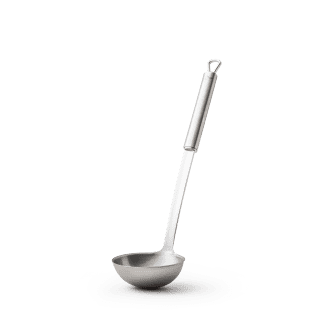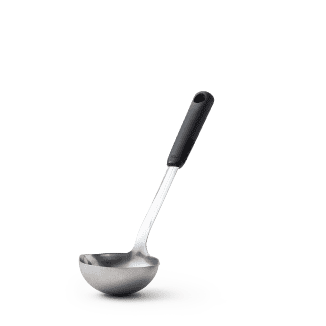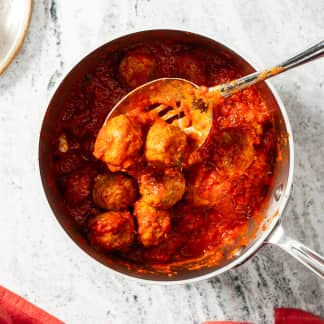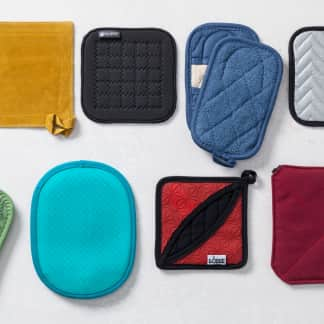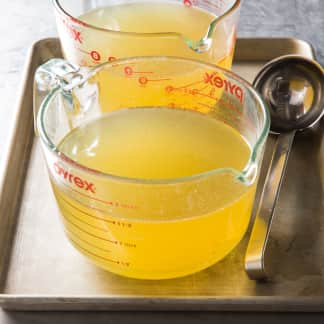Our longtime favorite ladle is the Rösle Hook Ladle with Pouring Rim. It holds just the right amount of liquid, pours neatly and precisely, and is comfortable to hold in different positions. For a less expensive option, we also like the Cuisinart Stainless Steel Ladle. It has a smaller capacity than our favorite and pours a bit less precisely, but it is still a pleasure to use. The Cuisinart Curve Handle Line Curve Nylon Ladle is our favorite nonstick-safe option. It has a big capacity, pours relatively neatly, and is especially easy to grip.

A good ladle is essential for scooping, portioning, and serving soups, stews, sauces, and sometimes drinks, desserts, and other liquids. Occasionally, we use ladles to press soups and purees through fine-mesh strainers to make them extra-smooth and silky.
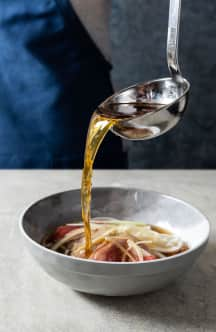

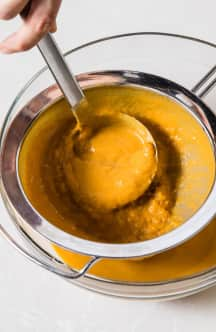
We use ladles for a variety of tasks, including serving soups and drinks and pressing purees through strainers.
Many of us prefer metal ladles, as they are sturdy and nearly indestructible. If you’re careful, you can use them with any type of pot or pan. But if you’re concerned about scratching your enameled or nonstick cookware, we recommend getting a ladle with a silicone or plastic bowl. These materials will be gentler on any surfaces they touch, though they can melt if exposed to high heat. We tested both stainless-steel and nonstick-safe versions, all with capacities of 4 to 7 ounces, the most commonly available sizes.
What to Look For
- A 5-Ounce Capacity: We found that bowls this size were ideal for dishing out soups and stews. Smaller models holding 4 ounces required a few extra passes to empty a pot of soup or stock, and larger versions of 6 ounces or more sometimes felt a tad unwieldy.
- A Pouring Rim: Most of the ladles did an acceptable job of serving soups and stews, but we slightly preferred those with pouring rims—bowl edges that were gently curved all the way around. These curved rims helped direct the flow of liquids, pouring more neatly and precisely than models with straight, vertical bowl edges or dedicated pour spouts. They also let us pour from anywhere on the bowl, unlike the models with dedicated pour spouts, which required us to pour from one side or another.
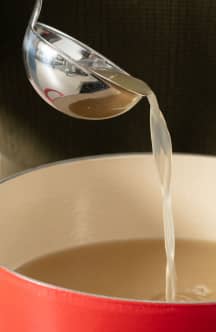

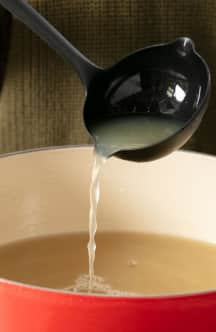
Models with gently curved pouring rims (left) consistently poured the most neatly and precisely and let us pour from anywhere around the bowl. Models that lacked rims (middle) were sometimes messy, and models with dedicated pour spouts (right) limited where we could pour from.
- A Rigid Bowl: We preferred models with bowls that were hard and rigid. They held heavy stews securely, without flexing, and were tough enough to force purees through a strainer effectively.
- A Medium-Length Handle Set at a 45-Degree Angle: Handles measuring 9.5 to 10 inches were long enough to reach into the depths of a stockpot, but not so long that they felt unwieldy. We liked those that were set at a moderate 45-degree angle in relation to the rim of the bowl. These kept our hands away from hot steam as we dipped into pots, unlike handles set at steeper 60- or 70-degree angles, which put our hands more directly in the line of fire and sometimes made us lift our arms or wrists into awkward positions.
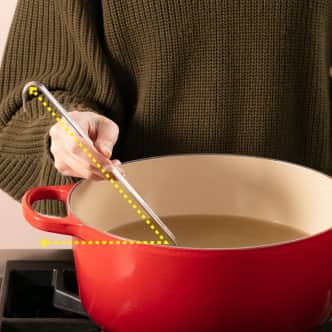
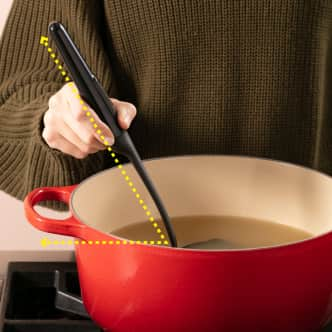
We liked models with handles set at relatively gentle 45-degree angles (left), as these made it easiest to dip into pots. Models with steeper angles (right) were more awkward to use and put our hands directly over the hot steam.
- A Smooth, Moderately Thick One-Piece Handle with Curved Edges: Moderately thick handles with rounded edges nestled into our hands most comfortably. We preferred those without dedicated grips; they were easier to hold in different ways. We also particularly liked handles made from a single piece of metal, silicone, or plastic, as they had no seams to collect debris.
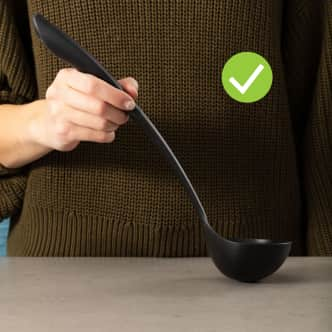
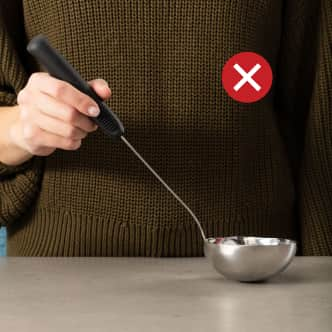
We preferred models made from a single continuous piece of material (left), as they allowed us a variety of hand positions. Models with dedicated grips (right) limited our hand positions and prevented us from choking up on the handle to increase control.
Nice to Have
- A Handle Made from Textured Material: We liked handles that were made from matte, textured, or rubbery materials, as they were easier to grip than handles made from slippery metal, especially in the hot steam of the stockpot.
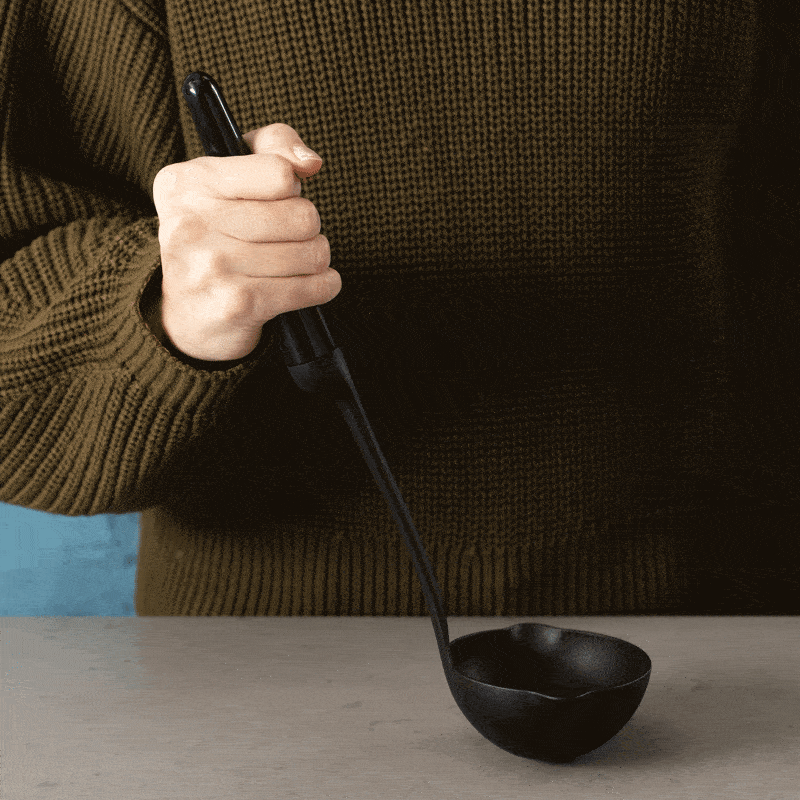
What to Avoid
- Floppy, Flexible Bowls: Floppy silicone and nylon bowls buckled and bounced under the weight of heavy stew or stock parts. They also weren’t sturdy enough to push purees through a strainer and made us worry about their longevity.
- Handles with Square Edges: Square edges cut into our hands as we scooped and served, proving especially uncomfortable to hold as we pressed soup through a strainer.
- Thick Handles and Handles with Dedicated Grips: Even testers with big hands found it uncomfortable to grip thick handles for long periods. Dedicated grips forced us to hold the ladles at the top of the handle, where we had the least control. You could choke up on these handles to gain control, but they were usually less comfortable to hold closer to the bowl.
- Empty a double batch of Classic Chicken Broth from a stockpot
- Serve Best Ground Beef Chili from a Dutch oven
- Force Creamless Creamy Tomato Soup through a fine-mesh strainer and then serve it
- Leave the ladles in a hot pot of soup for 3 hours and examine them for damage
- Have users of different hand sizes and dominant hands use the ladles








